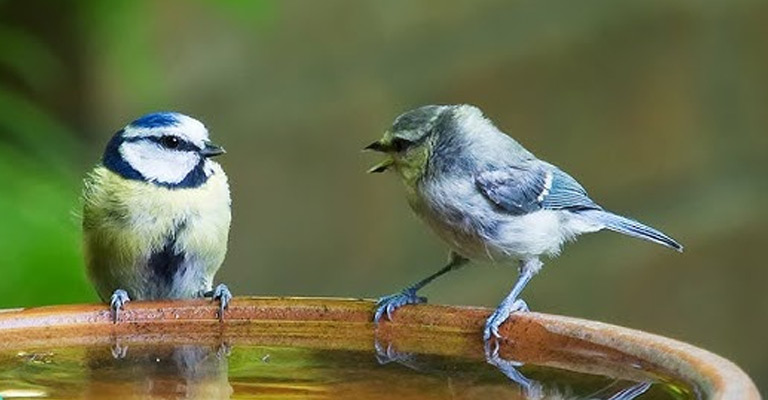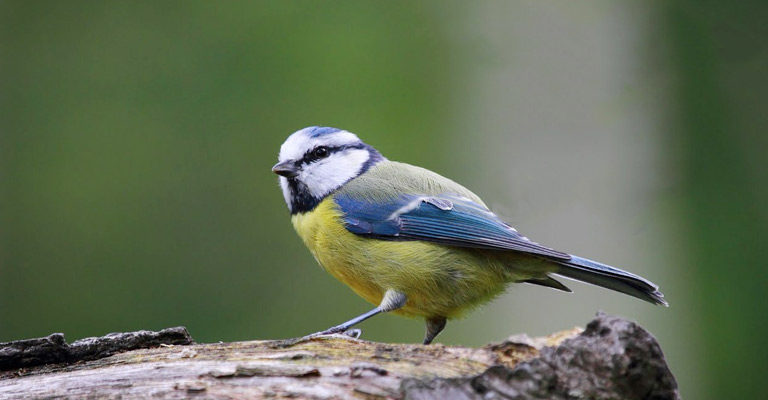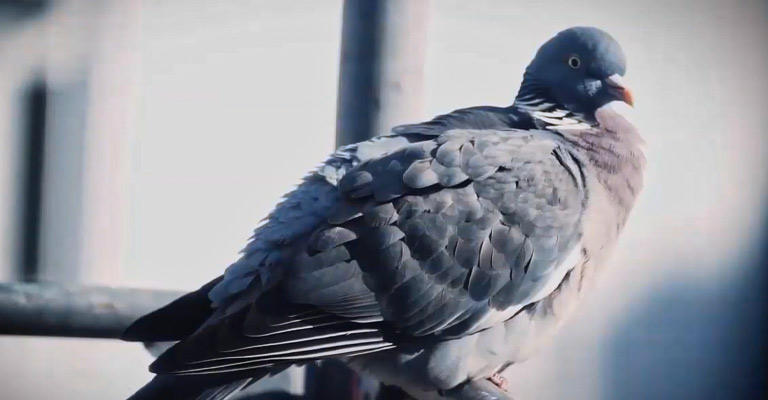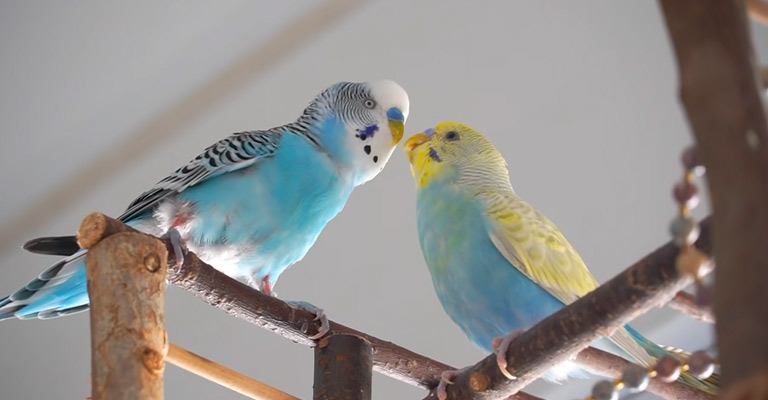Birds, with their diverse species and enchanting behaviors, have long captivated the fascination of birdwatchers, scientists, and nature enthusiasts alike. Beyond their stunning plumage and graceful flights, there lies a world of communication often hidden in plain sight.
In this blog post, we delve into the fascinating realm of avian communication and explore the various ways in which birds convey information to their peers, whether it’s through melodious songs echoing through the forests, intricate displays of feathers, or even subtle chemical cues.
From courtship rituals and territorial disputes to long-distance migrations and parenting, birds have evolved a rich repertoire of communicative strategies that shed light on their complex social lives and survival tactics.

How Do Birds Communicate With Each Other?
Birds communicate with each other using a variety of methods. Vocalizations are a common form of communication, with different calls and songs conveying information about territory, mating, danger, and more.
Visual signals such as plumage color and displays are also essential in courtship and territorial disputes. Body language, like head movements and postures, can convey aggression or submission.
Birds may use chemical signals through scent marking, important for finding mates or marking territories. Tactile communication occurs during courtship and bonding, as birds groom each other or exchange food.
Additionally, some species communicate through mimicry, imitating other birds’ calls or sounds to deceive or attract.
Social species often engage in group behaviors, like flocking or synchronized flying, to coordinate movement and share information. Overall, birds have evolved a range of communication strategies tailored to their specific needs and environments.
Vocal Communication of Birds

Vocal communication is a fundamental and highly developed means of interaction for birds. Birds produce a vast array of sounds, including calls and songs, to convey a wide range of messages to other members of their species.
Here, we’ll delve into the intricacies of vocal communication in birds:
Calls vs. Songs
Calls: Calls are short, simple vocalizations used for specific, immediate purposes. These can include warning of predators, alerting to food sources, maintaining contact within a group, or expressing distress.
Songs: Songs are longer and more complex vocalizations often associated with courtship and territorial behavior. They can convey information about an individual bird’s health, vigor, and genetic fitness.
Male birds typically sing to attract mates or defend their territory, while females may also sing, but less frequently.
Variability
- Birds exhibit remarkable diversity in their vocalizations. Some, like songbirds, are known for their intricate melodies, while others, such as waterfowl, produce more simple and repetitive calls.
- Each bird species has its own unique repertoire of calls and songs. The complexity and structure of these vocalizations can vary widely, even among closely related species.
Learning and Development
- Most songbirds learn their songs from conspecifics during a sensitive period in their early lives. This learning process is similar to how humans acquire language, with young birds listening to and imitating the songs of adult tutors.
- The ability to sing is not innate but acquired through practice and learning. Birds that are raised in isolation from their own kind often fail to develop proper songs.
Individual Variation
- Just as humans have accents, individual birds within a species can have variations in their songs. These variations can occur due to geographic isolation, social learning, or individual preferences.
- In some species, like the nightingale, individual males have unique repertoires, allowing females to identify and select mates based on song quality.
Communication Purposes
Birds use vocalizations for a myriad of purposes, including:
- Territorial Defense: Songs help establish and defend territories, signaling to other males to stay away.
- Courtship and Mating: Males often sing to attract females, demonstrating their fitness as potential mates.
- Parent-Offspring Communication: Parent birds and chicks communicate through calls to coordinate feeding and ensure safety.
- Alarm Calls: Birds alert their flock to the presence of predators through alarm calls, allowing for coordinated escape.
- Social Cohesion: Flock-forming species use calls to maintain group cohesion and coordinate movements during flight.
Environmental Adaptations
- Birds have adapted their vocalizations to suit their habitats. For example, in dense forests, songs may be more complex to transmit through the clutter of vegetation, while in open grasslands, simpler calls may suffice.
- Nocturnal birds, like owls, have developed specialized calls and hearing adaptations to communicate effectively in low-light conditions.
Vocal communication in birds is a multifaceted and sophisticated system that plays a crucial role in their survival, reproduction, and social interactions.
It showcases the remarkable diversity and adaptability of avian species, enriching the natural world with a symphony of sounds that serve as a testament to their evolutionary success.
Visual Communication of Birds

Visual communication is another crucial aspect of avian behavior, with birds employing various visual signals and displays to convey information to conspecifics and other species.
Here, we’ll delve into the intricacies of visual communication in birds:
Plumage Coloration
One of the most conspicuous forms of visual communication is plumage coloration. Birds use their feathers to display a wide range of colors and patterns, often for mating and territorial purposes.
- Sexual Dimorphism: In many species, males and females have distinct plumage differences, such as the vibrant plumage of male peacocks or the colorful throat patches of male hummingbirds. These differences help individuals recognize potential mates.
- Seasonal Variation: Some birds change their plumage seasonally. For example, the American goldfinch undergoes a molt, transitioning from a dull winter plumage to a bright, yellow breeding plumage to signal their readiness for reproduction.
Courtship Displays
Courtship displays involve a series of visual signals and behaviors used by males to attract females. These displays can include intricate dances, aerial acrobatics, and the flaunting of vibrant plumage.
- Dancing Displays: Birds like the sage grouse perform elaborate dances to showcase their physical prowess and court potential mates.
- Feather Displays: Peacocks fan out their iridescent tail feathers in an impressive visual display during courtship, while birds like the superb lyrebird lift and fan their tail feathers to create a mesmerizing show.
Territorial Displays
Many birds use visual signals to establish and defend territories. These displays deter rival males and signal to females that a territory is occupied.
- Physical Postures: Birds may adopt specific postures, such as puffing up their feathers or raising their crest, to appear larger and more intimidating to intruders.
- Fighting Displays: In territorial disputes, birds may engage in aggressive visual displays, including staring contests, beak displays, or bill snapping.
Parent-Offspring Communication
Visual signals are vital in parent-offspring interactions. Chicks often have distinct visual cues, like bright gapes or colorful markings on their beaks, to signal their hunger and elicit parental feeding.
Parents, in turn, use visual signals to locate and feed their offspring, recognizing their unique visual cues.
Agonistic Displays
Agonistic displays involve visual signals used during conflicts between individuals. Birds display aggression or submission to establish dominance or avoid confrontation.
- Threat Displays: Birds may puff up their plumage, raise their wings, or open their beak wide to intimidate rivals or predators.
- Submissive Displays: Conversely, submissive postures, like crouching, tucking the head, or exposing the back, signal surrender and intent to avoid conflict.
Species Recognition
Visual cues also play a role in species recognition. Birds can identify conspecifics (members of their own species) and distinguish them from other species based on visual traits.
This recognition is crucial in situations such as the formation of mixed-species flocks, where birds need to cooperate and forage together while minimizing aggression toward unrelated species.
Visual communication in birds is a diverse and intricate system that serves various functions in their lives, from attracting mates and defending territories to ensuring the survival of their offspring.
The remarkable diversity of plumage patterns and behaviors across avian species highlights the adaptability and evolutionary significance of visual communication in the bird world.
Bird’s Body Language and Postures

Birds use body language and postures as a non-vocal form of communication, conveying a wide range of messages to other birds and animals. These visual signals play a crucial role in various aspects of avian behavior and interactions:
Agonistic Behavior
Threat Displays: Birds may adopt aggressive postures to deter rivals or predators. For instance, a bird might puff up its feathers, lower its body, raise its wings, or extend its neck to appear larger and more intimidating.
Chasing and Pursuit: Some birds engage in aggressive chases to establish dominance or protect their territory. This behavior is often accompanied by rapid movements, flapping, and short bursts of flight.
Bill Displays: Birds may open their beak wide as a threat display, signaling readiness to bite or engage in combat.
Courtship and Mating
Dances and Rituals: Many species engage in elaborate courtship rituals that involve specific body movements and postures. For example, the courtship dance of cranes includes synchronized movements and leaps.
Preening: During courtship, birds often engage in mutual preening, where they groom each other’s feathers as a sign of affection and bonding.
Gift Offerings: Some species, like male bowerbirds, construct intricate displays of objects to impress potential mates.
Parent-Offspring Interaction
Feeding Postures: Parent birds may adopt specific postures to facilitate feeding their chicks. This can involve leaning over the nest, regurgitating food, and adjusting their body to ensure the chicks receive nourishment.
Brooding: Brooding birds use their bodies to provide warmth and protection to their eggs or chicks by covering them with their feathers.
Territorial Behavior
Territorial Displays: Birds may engage in territorial disputes, with postures like standing tall, holding wings out, or raising crests to assert dominance over a specific area.
Perching Height: The height at which a bird perches can also signal dominance within a group or territory. Higher perches are often occupied by dominant individuals.
Social Interaction
Submissive Postures: In group settings, birds may adopt submissive postures to avoid aggression from dominant individuals. This can include crouching, tucking the head, or making themselves appear smaller.
Play Behavior: Young birds often engage in playful behaviors, such as mock fights or aerial acrobatics, to develop social skills and establish hierarchies.
Predator Avoidance
Freezing: When faced with a potential predator, birds may freeze in place, using their cryptic plumage and stillness to blend into their surroundings and avoid detection.
Alarm Postures: Some birds, like plovers, feign injury by pretending to have a broken wing to lure predators away from their nest or chicks.
Foraging Behavior
Birds of prey, like eagles or hawks, adopt a specific hunting posture, characterized by a hunched body, keen attention, and precise movements when targeting prey.
Bonding and Social Cohesion
Birds often engage in allopreening, where they groom or clean each other’s feathers. This behavior reinforces social bonds within a group and helps maintain feather health.
Body language and posture are essential elements of avian communication. Birds use these visual signals to convey messages related to aggression, courtship, parental care, territory, social status, and more.
Understanding these non-verbal cues is crucial for birdwatchers, ornithologists, and anyone interested in decoding the complex and fascinating world of avian behavior.
Chemical Communication
Birds engage in chemical communication, although it is not as well-developed or prominent as other forms of communication, such as vocalizations or visual displays. Nevertheless, chemical signals play important roles in various aspects of avian behavior and ecology.
Here are some key aspects of bird chemical communication:
Scent Marking
Many birds have specialized glands located near their uropygial gland at the base of the tail, which secretes an oily substance. Birds use their beaks to spread this substance over their feathers during preening.
The secretions from the uropygial gland can contain chemical compounds that serve several purposes:
- Waterproofing: These oils help waterproof feathers, keeping the bird dry during rain and aiding in flight.
- Anti-Parasitic: Some components of uropygial gland secretions have antimicrobial properties, which can help reduce the growth of harmful microorganisms on the feathers.
- Individual and Species Identity: Birds may use these scent markings to establish their individual identity or species identity within a flock or territory. This can help them recognize familiar conspecifics.
Mate Selection and Recognition
Chemical cues may play a role in mate selection. Female birds may assess the scent of potential mates as an additional factor in their choice of a mate.
In some species, such as petrels and albatrosses, individuals can recognize their mates or nest sites by their unique scent, aiding in long-distance navigation during foraging trips.
Parent-Offspring Recognition
Chicks and parents in some bird species can recognize each other by scent. This recognition helps ensure that parents feed the correct chicks, even in dark or crowded nests.
Avoiding Predators
Some birds, especially ground-nesting species like quails, may use chemical cues to detect the presence of predators. The scent of a nearby predator can trigger alarm behavior or a change in foraging behavior.
Navigation and Homing
Some research suggests that pigeons and homing birds may use olfactory cues to aid in navigation and homing abilities. They might detect specific odors or scents in the environment to help them find their way back to their home loft.
Food Identification
In scavenging birds like vultures, a keen sense of smell plays a crucial role in locating carrion from a distance. These birds can detect the odor of decaying flesh, allowing them to locate potential food sources.
It’s important to note that while birds do use chemical communication, their olfactory (smell) capabilities vary greatly among species. Some birds have well-developed olfactory systems, while others have reduced or limited olfactory abilities.
Additionally, the study of chemical communication in birds is an evolving field, and ongoing research continues to shed light on the specific chemical cues and their functions in different avian species.
Birds’ Communication in Social Groups
Birds exhibit complex communication within social groups to coordinate activities, maintain social bonds, and ensure the collective well-being of the group. Communication in social groups is crucial for tasks such as foraging, defending territories, and raising offspring.
Here are some key aspects of bird communication within social groups:
Coordination of Group Movements
In flocks or groups of birds, communication is essential for coordinating movement, especially during activities like foraging and migration.
Birds use visual cues, vocalizations, and body language to signal changes in direction, alert to potential food sources, or indicate the presence of predators.
Alarm Calls
One of the most critical functions of communication within social groups is the signaling of danger. Birds within a group will emit alarm calls to warn others of nearby predators.
Alarm calls vary in intensity and specificity, with some birds having different calls for different types of threats. This allows group members to respond appropriately, whether it’s taking flight or seeking cover.
Foraging and Food Sharing
In communal foraging scenarios, birds often use calls or body language to indicate the discovery of food. This information-sharing benefits the entire group by increasing foraging efficiency.
Cooperative species may also engage in food-sharing behaviors, such as regurgitating food for nestlings or offering food to other group members.
Territorial Defense
Birds that defend territories or communal nesting sites rely on communication to deter intruders and protect their resources.
Displays of aggression, including vocalizations and physical postures, serve as warnings to rival individuals or groups to stay away.
Courtship and Mating
Social groups can play a role in courtship and mate selection. Some species engage in elaborate group displays or coordinated behaviors to attract potential mates.
In lekking species, males gather in groups to display and compete for the attention of females. These displays often involve vocalizations and physical postures.
Social Hierarchy
Within social groups, hierarchies may develop based on factors like age, sex, or dominance. Communication, such as submissive postures or vocalizations, helps maintain order within the group.
Dominant individuals may use body language and vocalizations to assert their status and maintain control over resources.
Parent-Offspring Interaction
Communication between parents and offspring is vital for the survival and development of young birds within a social group. Parents provide food and protection based on cues from their chicks’ vocalizations and behavior.
Nestlings often communicate their needs through begging calls, which signal hunger and prompt parents to feed them.
Social Bonding
Birds in social groups form bonds with specific individuals, often through grooming, allopreening (mutual grooming), or other affiliative behaviors.
These social bonds can enhance cooperation within the group, reduce conflict, and promote overall group cohesion.
Communication within social groups of birds is a multifaceted and dynamic process that contributes to the success and survival of group members. Through vocalizations, body language, and various other cues, birds in social groups are able to navigate their complex social interactions, from foraging and territorial defense to courtship and parenting.
These intricate communication systems highlight the adaptability and intelligence of avian species.
Long-Distance Communication of Birds
Long-distance communication in birds refers to the ways in which birds convey information over significant distances, often beyond the immediate vicinity of their territories or social groups.
Birds have developed various strategies for long-distance communication to serve several essential purposes, including navigation, finding mates, and identifying conspecifics. Here are some notable examples:
Vocalizations
Birds employ calls and songs that can carry over long distances to communicate with individuals that may be out of sight. These vocalizations serve various functions:
Territorial Announcements: Many bird species use songs to establish and defend territories, allowing neighboring birds to recognize and respect boundaries.
Mate Attraction: During the breeding season, males often sing to attract females. The quality of a male’s song can convey information about his fitness and genetic quality.
Contact Calls: Birds use contact calls to maintain communication with their mate, family members, or flock members, even when they are separated.
Migration Calls
Migratory birds often produce distinct calls during their migrations. These calls can serve several purposes:
Coordination: Migrating flocks use calls to coordinate their movements and maintain group cohesion during long flights.
Orientation: Young birds may learn the migration routes and directions by listening to the calls of experienced adults.
Location: Birds may use calls to announce their presence to other migrants and to find suitable stopover sites along their migration route.
Visual Displays
Some birds employ visual displays that are visible over long distances. These displays are often used for courtship and territory defense:
Aerial Displays: Birds like raptors engage in spectacular aerial displays, which can be seen from great distances. These displays are used for mate attraction and territory assertion.
Lekking: In lekking species, males gather in specific locations and perform visual displays to attract females. These displays are often visible from afar.
Chemical Signals
In some cases, birds may use chemical cues that can be detected over long distances. For example:
Pheromones: Certain species may release pheromones during the breeding season to signal their presence and readiness to mate. These chemical signals can be detected by potential mates at a distance.
Infrasound and Ultrasound
Some birds, like pigeons, can produce infrasound (below the range of human hearing) during their courtship displays. This infrasound can travel long distances and may help females locate displaying males.
Conversely, some owls use ultrasound to communicate with conspecifics during the breeding season. These high-frequency calls are inaudible to many potential prey species but can be heard by owls over long distances.
Light Signals
In nocturnal birds, light signals can serve as a form of long-distance communication. Fireflies, for example, use bioluminescent flashes to communicate with potential mates.
Long-distance communication in birds is a fascinating aspect of their behavior and ecology, allowing them to convey crucial information across vast landscapes.
These communication methods have evolved to facilitate essential functions like navigation, reproduction, and social interactions in various avian species.
FAQs
Birds use a variety of calls and songs to convey messages. Calls are typically short and serve immediate purposes like warning of danger, while songs, often more complex, are used in courtship and territory defense.
No, not all bird species sing. While many songbirds are known for their melodious tunes, others, like waterfowl, produce simpler vocalizations. Some non-songbirds communicate through calls and other sounds.
Birds employ loud and distinctive calls and songs to communicate across long distances. These vocalizations can carry through the air and help them maintain contact with mates, and flock members, or coordinate migrations.
Yes, birds use visual cues like plumage coloration, displays, and body language. These signals are important in courtship, territorial defense, and conveying information about health and status.
Yes, some birds use chemical communication through glandular secretions. The uropygial gland, located near the tail, produces oils that can carry chemical signals related to waterproofing, antimicrobial protection, and individual or species identity.
Wrapping Up
In the avian world, communication isn’t just about making noise; it’s a nuanced language of survival and connection.
From the mesmerizing melodies of songbirds to the majestic dances of birds of paradise, and even the chemical whispers of the uropygial gland, birds have developed an array of tools to navigate their environments and interact with their fellow feathered companions.
Understanding the intricate ways in which birds communicate enriches our appreciation of these magnificent creatures and reminds us that even in the quietest of moments, a vibrant conversation unfolds in the world of birds, a testament to the wonders of the natural world.
Hopefully, you have got the point. Thank you for your time.